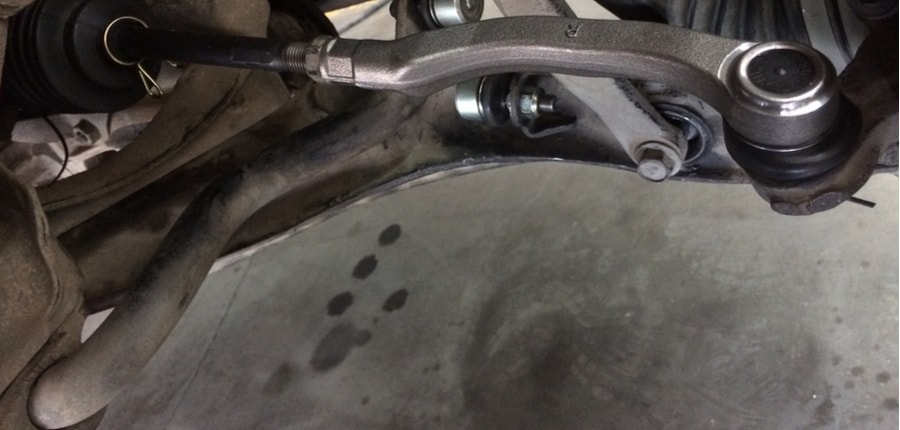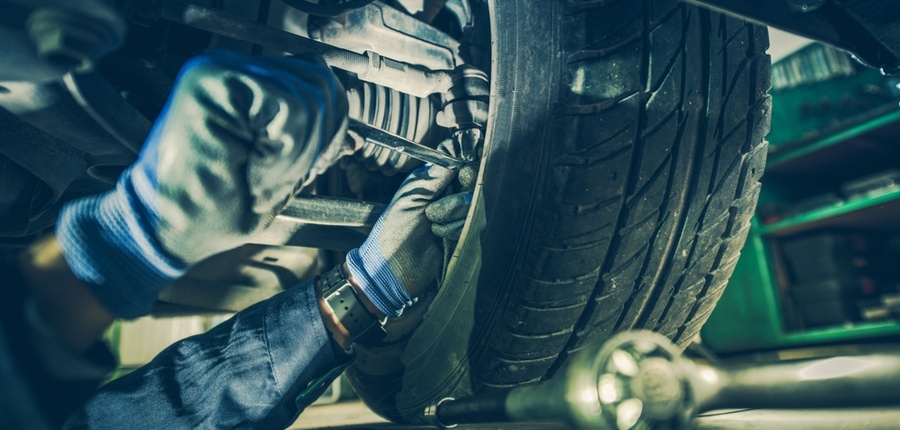On an automobile, whether a light truck or a passenger car, the steering forces are carried from the central steering gearbox or rack and pinion out to the steering arms by tie rods. An inner tie rod and an outer tie rod are present on each side, and each of these has a ball socket, allowing a range of movement.
On a vehicle that uses a rack and pinion steering assembly, the outer tie rod ends have a tapered pin that bolts into the steering arm. The body of the outer tie rod end is usually cast iron and machined with internal threads that the inner tie rod screws into.
The inner tie rod threads into the outer, allowing the total length of the two to be adjusted for the purpose of aligning the front wheels. On the opposite end of the inner tie rod, on the ball-socket side, there is another threaded end that screws into the steering rack assembly.
Signs that a Tie Rod End Might Need Replaced
Tire wear is usually the first sign. Looseness in a tie rod will allow toe angles to shift, which will cause wear on the inner and/or outer shoulders of the front tires. Sometimes it is possible to feel the looseness in the steering, but usually not. Sometimes a tie rod can be loose enough to cause noise, but that’s also rare. Most of the time, the noticeable problem is tire wear. Fairly often, this is noted when a vehicle is getting a tire rotation or being checked on an alignment rack.
Contrary to what is written sometimes, a tie rod will not cause a shake in the steering wheel or vehicle, any more than a wheel alignment issue will. A loose front end part may allow a shake to be worse than it would be with good parts, but it won’t cause a shake.
Tie Rod End Replacement Costs
The basic labor time for replacing an outer tie rod end is usually 3 to 4 tenths of an hour. If a vehicle uses a steering gearbox, the time to replace an inner tie rod end will also usually be 3 or 4 tenths of an hour. If a vehicle uses a rack and pinion for steering, there is a great deal more variety in the labor time of replacing an inner tie rod end. For some examples of tie rod replacement costs on common vehicles, using $150 an hour as a labor rate, see:
- On a 2007 BMW 328i, the labor time for the inner tie rod replacement is around 4.0 hours (with steering rack removal). A factory inner tie rod end costs around $209 and a Moog replacement part is about $36. That makes the cost of the job about $809 using a factory part and around $636 using an aftermarket part. To replace an outer tie rod for, the labor time is 0.4 hours. A factory outer tie rod end costs around $125 and a Moog replacement part is around $22. The cost of the job in that case is around $185 using a factory part and around $82 using an aftermarket part.
- On a 2006 Chevrolet Silverado 1500, the labor time for an inner tie rod replacement is around 0.9 hours. An ACDelco tie rod price is about $34; making the total job cost about $169. To replace an outer tie rod end, the labor time is around 0.6 hours and an ACDelco part is about $35. The cost of the job in that case for an outer joint is around $115.
- On a 2010 Ford Fusion, the labor time for an inner tie rod replacement is around 3.1 hours (with steering rack removal). A factory replacement part costs around $47 and a Delphi replacement part is about $28; making the total cost to complete the job around $512 using a factory part or $493 using an aftermarket part. To replace the outer tie rod end of this vehicle model, the labor time is around 0.4 hours. A factory replacement part costs about $70 and a Delphi replacement part costs about $32. The cost of the job in that case is about $130 using a factory part, or about $92 using an aftermarket part.
- On a 2006 Mazda 3, the labor time for an inner tie rod replacement is estimated at 3.0 hours (with steering rack removal). A factory replacement part costs around $80 and a Proforged replacement part costs around $24. That would make the job cost about $530 using a factory part and about $474 using an aftermarket part. To replace its outer tie rod, the labor time is approximately 0.4 hours. A factory replacement part costs around $75 and a Proforged part is around $26. The cost of the job in that case is about $135 using a factory part or around $86 using an aftermarket part.
Other Cost Considerations
In addition to the parts costs for factory and factory-equivalent tie rod ends, there are “economy” replacement parts commonly available. These usually range from about $10 to $20. Opinions vary as to quality. Whereas a good-quality front end part from a name-brand manufacturer will often carry a lifetime warranty, economy parts usually come with a one-year warranty.
On top of all those cost estimates, any time a tie rod is replaced, the vehicle will need to be aligned. The range of costs for a wheel alignment is around $50 to $150, depending on the vehicle and shop.
It’s usually best to have tie rod replacements done at a shop that is equipped to also do the wheel alignment so that the vehicle doesn’t need to be driven without having the alignment set.
It’s worth mentioning that the labor times for inner tie rod replacement, which include the removal of the steering rack, involve procedures that are rarely followed. It’s much more common that the inner tie rod can be replaced without removing the steering rack using special tools that are commonly available. In many cases, a shop will charge a flat rate for the work, which is more fair and realistic than book time for the job, typically about 2 hours.
One thing that comes up frequently is that if one tie rod is worn, sometimes, a shop will recommend replacing all the tie rods at the same time. There are some cost savings when replacing all the parts at the same time due to overlapping labor, but the main decision might be best made based on how long the vehicle is intended to be kept.
Mechanically, there is no reason to replace a part that hasn’t failed. But on a high mileage vehicle that is intended to be kept on the road and kept reliable over the long-term, it may be a reasonable choice. If one part fails due to normal wear and tear, the other parts that experienced the same wear and tear may not be far behind.

Tie Rod End Replacement
Replacement of the outer tie rod end is very simple—a matter of breaking the tapered pin loose from the steering arm and unscrewing the part from the inner tie rod end. Replacing the inner is often more complicated due to restricted access, and occasionally, there is a need for a special tool to turn the inner socket.
On a vehicle with a steering gearbox, the inner and outer tie rod ends are often nearly identical. While the outer has a tapered pin that bolts to the steering arm, the inner has a tapered pin that bolts to a center link.
The inner and outer will usually be connected by an adjusting sleeve, and the replacement of either is a simple matter of breaking the tapered joint and unscrewing the tie rod end from the sleeve.
On a vehicle with a solid front axle, such as some 1-ton trucks, there are often only two outer tie rod ends (no inners) with an adjusting sleeve connecting them. These run from one steering arm to the other, and steering is accomplished by a drag link that runs down from the steering gearbox and connects to another steering arm at the knuckle, or to one of the outer tie rod ends.
The advantage of this system on a vehicle designed for towing and heavy loads is that the toe and camber angles are fixed solidly and don’t change with ride height.
How Tie Rod Ends Fail

The most common failure is looseness due to wear in the ball and socket ends of the tie rod. A small amount of wear is usually not noticeable when driving, but will show up as tire wear.
Any play directly affects the toe angles of the wheels, which is the primary wear angle of the wheel alignment. A larger amount of looseness can be felt as loose steering. Where the vehicle wanders, the steering has to be corrected often to keep it driving in a straight line, and the steering wheel has to be turned significantly before the vehicle responds.
This is easy to diagnose with a vehicle up on a lift, as the front wheels are “shaken down” in a standard suspension check. On most modern vehicles, there should be no noticeable play in the wheel, side-to-side or up and down. Various other things can cause play, but tie rod ends are the most common.
Physical damage is also possible. A curb hit, for instance, transmits a great deal of sudden force into the tie rod end, and it can bend. In some cases, the tapered pin can shear off; at which point the vehicle is undrivable.
In some areas where the roads are salted, sometimes, for no obvious reason, the tie rod adjusting mechanism can freeze up. If alignment adjustments need to be made at a tie rod but the part cannot be freed up to allow adjustments, it’s usually recommended that the part be replaced—often both the inner and outer joint together.
Outer tie rod ends have a small boot that protects the joint from road grime and weather. The inner tie rod ends on a steering rack have a bellows that protects the joint.
In either case, if the boot or bellows are torn, that can allow the grease to escape or dry out and the grit and water to enter, which can lead to rapid failure. It was normal in the past for tie rod ends to have a grease fitting that allowed them to be regularly serviced, but this is becoming increasingly rare. Name-brand aftermarket parts often provide a grease fitting, even where the OE part being replaced lacked one.
Frequently Asked Questions
Replacing an outer tie rod is usually easy and possible for a vehicle owner to do. Replacing an inner tie rod end is about the same level of difficulty on a vehicle that uses a steering gearbox. If the vehicle has a rack and pinion, though, that usually requires special tools and procedures to replace an inner tie rod end correctly.
No, it doesn’t work that way. There isn’t a spec for the length of the threaded section of a tie rod end, it can be arbitrary, so counting threads doesn’t help much when installing new parts.
It depends on how loose the parts are. The two main things that cause this are lack of steering control and tire wear. Both of those are pretty important, and it is usually cheaper to replace worn tie rod ends than it is to replace worn out tires.
